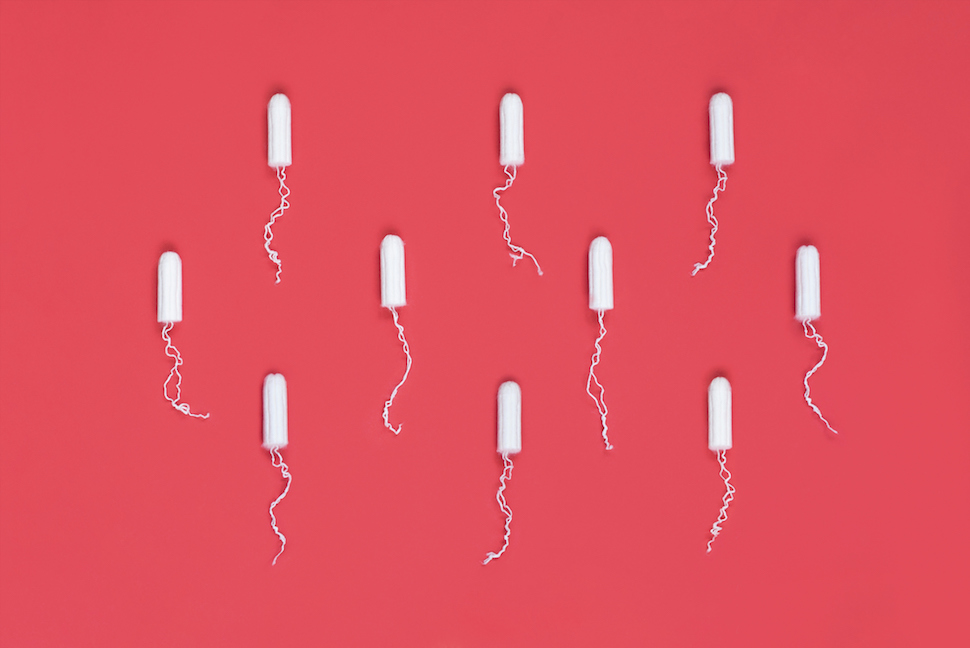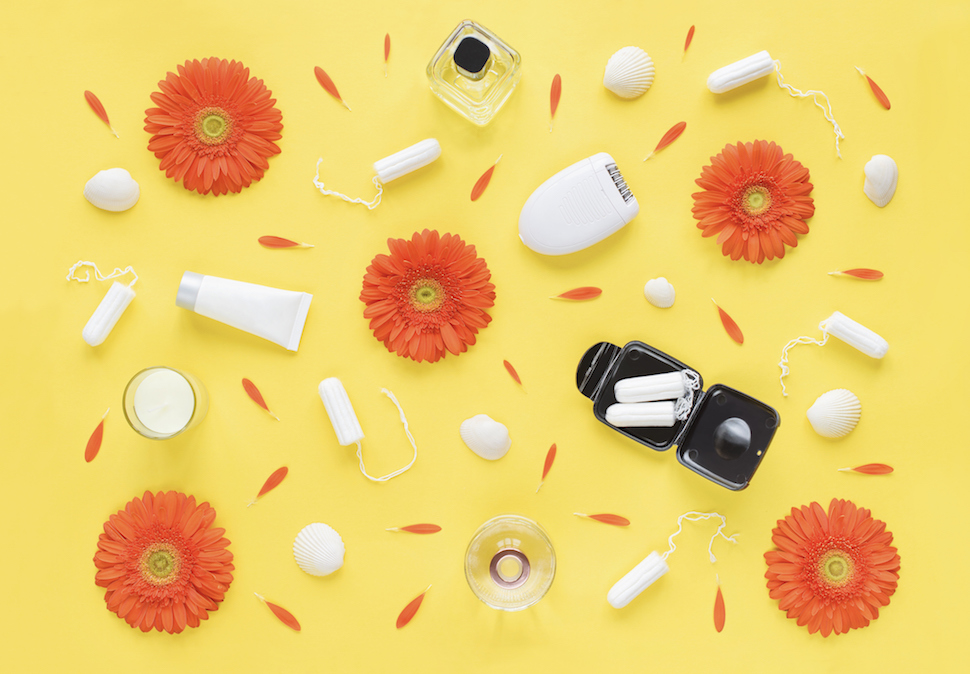Table of Contents
Are organic tampons worth the switch?
Are they better?
Safer?
Healthier?
If you make an effort to eat well when you can and you choose cosmetics based on ingredients, you’ll love this deep dive.
And if you’re itching to get pregnant or are currently TTC, stick around—or scroll right to #8 below.
Because after hours spent reading and watching last year’s FDA testimony on cosmetic safety, my first thoughts were about (of all things, I know…) toxic tampons.
Because if the products we use on our bodies are so unregulated, how about the ones we use in our bodies?
For hours at a time. Every. Single. Month.
Hoping to make peace with your privates? Switching to organic cotton tampons is something you’ll be thanked for profusely—scientifically speaking. Here are 10 reasons your V will love you for it.
1. We Don’t Know What’s In Our Tampons
The FDA thinks of your tampons as medical devices, not cosmetics, so their ingredients don’t legally have to be listed—and manufacturers see them as trade secrets that are best not shared.
Right.
Since we know that even products that do list their ingredients can’t always be blindly trusted, let’s just raise a red flag mentally.
In October 2019, New York passed the “Menstrual Products Right to Know Act,” changing this for their citizens.
2. We Use 10,000-16,000 Tampons in Our Lifetime
According to an infographic from San Francisco State University, we women menstruate on average from age 13 to 51 and have about 456 periods over those 38 years. Each cycle lasts from 3 to 7 days — roughly 2,280 days or 6.25 full years.
About 70% of women use tampons, changing them out every 4 to 8 hours.
Taking 6 hours as the average means “4 tampons per day x 5 days of a period = 20 tampons per cycle x 456 periods = 9,120 tampons [throughout your lifetime].”
That’s a long time to have a wad of anything pressed up and against our inner vaginal walls. Anything we do or use that often, especially in our private parts, is something we’ll want to be sure is uber safe.
3. The V is One of Our Most Chemical-Absorbent Body Parts
According to the Textbook of Modern Toxicology, for men, the scrotal skin is the most toxin-absorbent surface of the body, and the palms and soles are the least absorbent.
Which, might I ask, do you think the vagina is more like?
Also, in a brilliant article from March 2014 in the Environmental Health Perspectives Journal, award-winning author Wendee Nicole poses “A Question for Women’s Health: Chemicals in Feminine Hygiene Products and Personal Lubricants.”
Her research is pure genius and a couple of choice quotes say it all:
- “It is well known that the vaginal ecosystem is more sensitive and more absorbent than typical skin.” – Alexandra Scranton, Director of Science and Research, WVE
- “As a mucous membrane, the vagina is capable of secreting and absorbing fluids at a higher rate than skin, as are some of the external portions of the vulva, including the clitoris, clitoral hood, labia minora, and urethra.”
- “One study found that vaginal application of estradiol, a synthetic estrogen, resulted in blood serum levels 10 times higher than those following oral dosing.”
- “Chemicals from plastics may also be of potential concern, given that many of these feminine hygiene products have applicators.” – Ami Zota, Assistant Professor of Epidemiology, GWU
- “All [synthetic] fibers cause the production of large quantities of toxins absorbed by the vaginal mucosa, which is highly vascularized.” – Philip M. Tierno, Ph.D., Clinical Microbiology and Pathology Professor, NYU
According to a 2004 New Jersey Medical School study, the vagina is actually “an ideal site for drug delivery.”
That same study tells also us, “Female hygiene products and douches wash away a variety of the vaginal defenses and can promote colonization of bacteria or alter vaginal pH, allowing pathogenic bacteria and yeast to proliferate,” and that, “Tampons or any absorbent material become media for bacterial colonization and growth.”4. Vaginal Toxins Bypass the Liver — the Hepatic First Pass Effect
The NJ Med School study I mentioned earlier also discusses what’s called the “hepatic first-pass effect” — that’s when you ingest a drug or poison, how much of it is metabolized by the liver or other metabolically-active tissues of your body, resulting in a reduced concentration of that drug arriving at its intended site in the body.
Oral drug doses for instance account for the fact that “for every 20 molecules of nitroglycerin given by mouth, only 1 makes it past the liver to reach the rest of the body.”
Toxins coming in via the vagina bypass this safety system.
That 1-in-20 quote is from Gary Theilman, a Doctor of Pharmacy at the University of Mississippi. Here’s the rest of it:
“One of the liver’s most important roles is to protect us from toxic substances we might swallow.
“Unfortunately, the liver also ‘protects us’ from many drug molecules that we give orally. In many cases, only a small fraction of the original drug makes it through that first pass through the liver. For example, for every 20 molecules of nitroglycerin given by mouth, only 1 makes it past the liver to reach the rest of the body.
“One strategy to overcome the first-pass effect is just give a lot of the drug…
“For example, when treating heart rhythm disturbances, we may give up to 10X more Propranolol by mouth than we really ‘need.’ Most of the Propranolol is removed by the liver in the first pass, but enough gets through to the heart to control the rate.”
Now, let’s check out that peer-reviewed NJ Med School study about vaginal drug administration again, and think of your toxic tampons while you read it. I added the emphasis, in bold.
- “GI tract and hepatic first-pass effect are avoided.”
- “Although clinicians commonly use topically administered drugs in the vagina, this route for systemic drug administration is somewhat novel.”
- “Experience with a variety of products demonstrates that the vagina is a highly effective site for drug delivery, particularly in women’s health.”
- “The vagina is often an ideal route for drug administration because it allows for the administration of lower doses, steady drug levels, and less frequent administration than the oral route.”
- “With vaginal drug administration, absorption is unaffected by gastrointestinal disturbances, there is no first-pass effect, and use is discreet.”
5. Vaginally-Absorbed Chemicals Can Have a Systemic Effect, Not Just a Local One
Systemic means affecting the entire body, rather than a single organ or body part. So if a drug or toxin had only a local effect, it would impact only the vagina and its surrounding tissue. But if it had a systemic effect, it could affect the whole body.
In a November 1917 study titled, “On the Absorption of Drugs and Poisons Through the Vagina,” David Macht from the Pharmacological Laboratory, Johns Hopkins University, writes:
“The vagina is generally regarded as an organ incapable of absorbing pharmacological agents. Witness to the widespread belief is the universal and indiscriminate employment by women of all kinds of medicaments—some known to be innocuous and others recognized, otherwise, as violent poisons—in the form or douches, tampons, suppositories, ‘uterine wafers,’ etc. Such a practice is not only condoned by the majority of medical men but is often deliberately recommended by them, the prevalent opinion among the profession being that drugs applied to the vagina desert only a local effect and are not absorbed into the system.”
This then-widespread belief, he proved wrong.
Experimenting with cats and dogs (whose vagina is “histologically [meaning, the microscopic structure of tissue] practically the same as that of the human being”), the study looked at the absorption rates and effect of numerous chemicals, antiseptics, and drug-soaked tampons: “A tampon soaked with a 5 per cent solution of the salt and introduced into the vagina…” or a “1 : 1000 solution of bichloride…”
Some of their findings? (Again, I’ve bolded the important bits if you’re skimming.)
- “…it is evident that all kinds of pharmacological agents…can be and are comparatively easily absorbed through the vaginal walls.”
- “The prevalent opinion that medicaments ministered through vaginal douches, tampons and other forms of treatment exert only a local action has undoubtedly been responsible for a great many cases of dangerous poisoning and may be the explanation of a still greater number of chronic intoxications of an indefinite character.”
- “The histories just cited are sufficient to emphasize the enormous toxicological, hygienic and sociological importance of the role played by the absorption of various poisons through the vaginal route.”
- “The above-described experiments… on the other hand emphasize the great danger of the indiscriminate employment of various poisonous substances in the form of douches, tampons, ‘uterine wafers,’ etc.”
Yes, a lot has changed since 1917 about our drugs and how we take them and we now know, for instance, that mercury causes heavy metal poisoning—but what hasn’t changed?
The vagina!
It’s still absorbing what chemicals we put it into contact with.
And there are definitely, definitely chemicals in every nonorganic tampon.
Definitely. Unquestionably. Zero argument. No one contests this.
They just say it’s not that much, or not enough to be significant.
Uh… TSS anyone? Debilitating cramps anyone? Infertility anyone? Yes!
We wear tampons for HOURS at a time, day after day.
In the most chemically-absorbent part of our body.
6. Tampon Cotton Is Commonly Doused in Pesticides, Herbicides & Insecticides
Every year, cotton growers around the world use over 10% of the world’s pesticides and almost 25% of the world’s insecticides.
And they use many of the most hazardous pesticides available, and in ever-increasing numbers:
From 2009 to 2012, annual pesticide use increased by 113 million pounds, from 649 million to 762 million.
7. 85+ percent of Tested Tampon Cotton Contained a Carcinogen
In a 2015 Argentinian study, between 85% and 100% percent of raw cotton, sterile gauze and tampons tested were found to contain glyphosate, something the WHO’s International Agency for Research on Cancer (IARC) has classified as a Group 2A carcinogen: “Probably carcinogenic to humans.”
Glyphosate is the active ingredient in Roundup and is the most widely-used agricultural chemical of all time.
Roundup’s manufacturer, Monsanto, says it poses no threat to humans. Classic. I’m pretty sure J&J said the same before being ordered to pay billions for its evidently cancer-causing baby powder.
While this 2015 Argentinian study is years old, as of 2020, the US Department of Agriculture (USDA) says that 94% of cotton produced in the U.S. is genetically engineered.
Yikes.
8. The World is Slowly Going Infertile. And We Don’t Know Exactly Why.

I’m not gonna suggest that we women play the sole role in infertility (we don’t), or that tampons alone are to blame (they’re not).
But I am gonna say that for the most part, we’re evidently all actually going a little infertile–and experts don’t exactly know why.
Most people may have missed this since the latest news broke right at the start of this lil’ global pandemic, but had you been watching headlines, you’d have seen:
Fertility & Birth Rate Nose Dive:
(This gets depressing quickly, so I’ve listed just 10.)
- “Italy faces existential threat over low birthrate” – Reuters
- “Australia’s fertility rate falls to record low” – Sydney Morning Herald
- “China’s Birth Rate Sank to Lowest Level on Record Last Year” – TIME
- “Birth rate plunges to 80-year-low in England and Wales” – Independent
- “Europe needs many more babies to avert a population disaster” – Guardian
- “Fewer births, more deaths sees lowest French growth rate since WWII” – RFI
- “Japan Shrinks by 500,000 People as Births Fall to Lowest Number Since 1874” – NYT
- “Alarming low birth rates shut down schools in Greece.” – Euractiv
- “Spain: 40% Fewer Babies in 11 years” – AllianceVita
- “The Big Number: U.S. Birth Rate Drops to All-Time Low of 1.73” – Washington Post
- “Birth Rate in U.S. Falls to Lowest Level in 32 Years, CDC Says” – MSNBC
Baffled Experts:
- “Historically Low U.S. Fertility Rate Baffles Experts” – LifeWay
- “The Emptying Planet: The Global Impact of Declining Fertility Rates, A Virtual Roundtable” – CFR
- “Male Infertility Crisis in U.S. Has Experts Baffled” – Newsweek
- “A ‘New’ Normal? An Updated Look at Fertility Trends Across the Globe” – Institute for Family Studies
Now, there are soooo many factors involved in fertility—diet, exercise, obesity, EMFs, electricity, and environmental toxins, and tampons are definitely not the sole cause. But that being said, if with all this new info here you suddenly felt that tampons affected your fertility, well, you wouldn’t be the first to have arrived at that thought.
And, even better, if you stopped using toxic tampons altogether and were suddenly able to get pregnant, you wouldn’t be the first to do that, either.
And I think that’s pretty hopeful.
Even skyrocketing rent and the cost of childcare might play roles in our fertility rate. But experts are officially semi-baffled so it’s really anyone’s guess.
Or, technically speaking, science is never actually settled.
And while they’re investigating and rethinking, one of the smartest things you can do is just…go 100% organic. Please?
So if you’re currently TTC, or planning to anytime soon, I’d suggest you go organic in the yoni/coochie department—or start using a menstrual cup.
Made of 100% medical grade silicone, menstrual cups are a healthier option than tampons, organic or not.
(Since we haven’t covered that tampons don’t just leave their own fibers behind, but your own tissue as well, that should be coming out with each menstrual cycle.)
Cups tend to end up more comfortable than tampons. BUT, they are a bit out there and take some “getting used to” if you know what I mean.
You’ll also want a sterilizer as well, and this one from iNeibo on Amazon is decent. They all do virtually the same thing, which is sterilizing the cup with steam (since they’re reused), or you can place them in water that’s at a near-boil, just get a stainless steel or iron pan you’ll dedicate to that.
9. Organic Tampon Benefits Make Them Actually Worth It

Sadly, actual science in the area is in its infancy, so the benefits of organic cotton tampons currently come down to what actual users report, which typically includes:
- They’re free from chemicals and additives that can cause or contribute to reproductive and developmental problems, immune system damage, hormonal interference, and even cancer
- The applicators are free of BPA and BPS
- Shorter periods
- Fewer cramps or no cramps at all
- No irritation
- Hives either clear up or don’t happen to begin with
- Less hormonal and cranky
10. Organic Cotton Tampons Are [Finally] Comfortable & Effective
Unlike regular tampons, organic tampons are made of 100% organic cotton and are made without dyes, rayon, plastic, fragrance, bleach, pesticide, deodorants, synthetic adsorbents, or phthalates.
So, here they are—
Top Organic Cotton Tampons Options
- L Organic Cotton Tampons
- Cora Organic Cotton Tampons
- Rael Organic Cotton Unscented Tampons
- Seventh Generation Organic Cotton Tampons
- o.b. Organic Cotton Tampons
- Tampax Organic Cotton Tampons:
This article was critically reviewed by Dr. Eric Huntington


